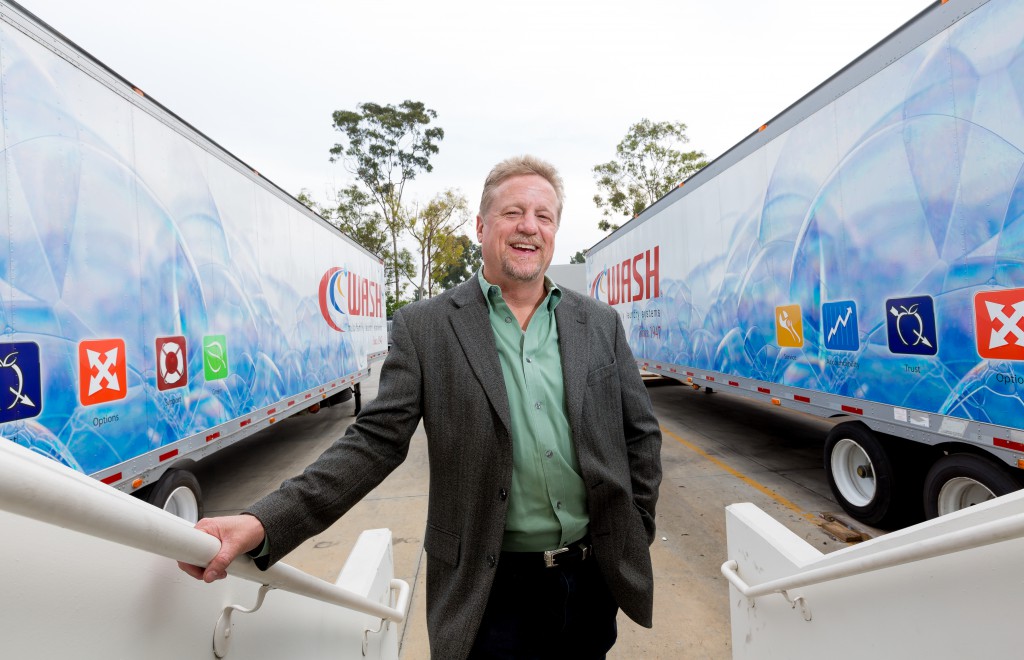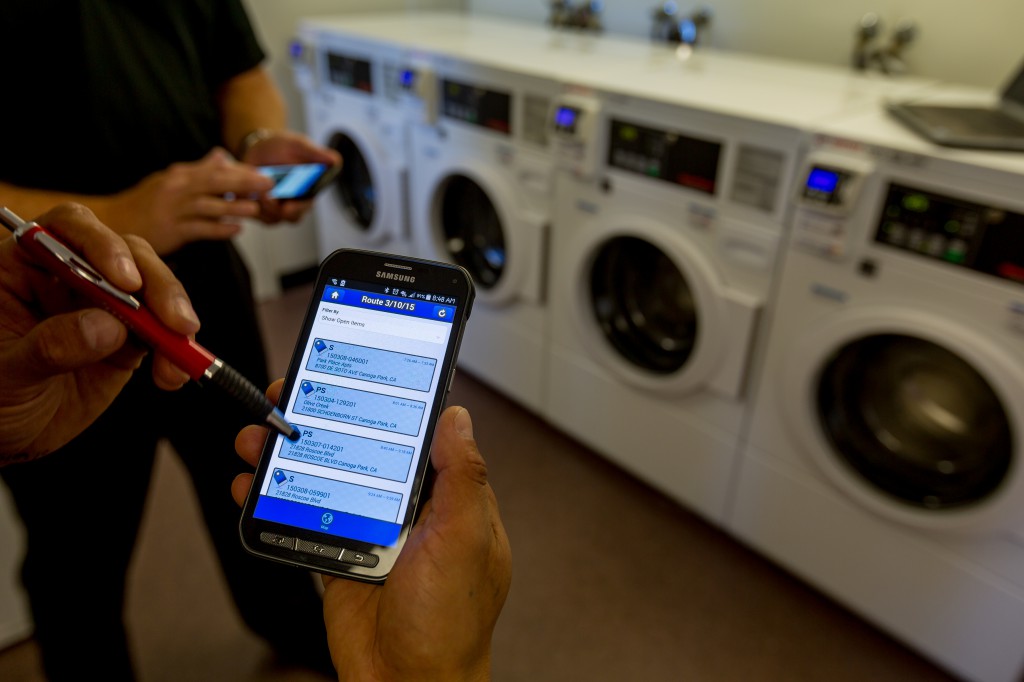
WASH Multifamily Laundry cleans up on technology that boosts efficiency in operations, repairs and inventory
You know the routine. Dive into the hamper. Pull out your family’s dirty PJs, work/school outfits and gym clothes. Add detergent and bleach. Suds up, rinse, spin and dry. Repeat for the next load. Fold and hope your socks match up.
If you’re doing all this regularly at an apartment complex, college or military base, there’s a good chance you’re doing it in a laundry room with machines installed and maintained by the Los Angeles-based WASH Multifamily Laundry Systems.
WASH, founded in 1947, is responsible for the upkeep of half a million washers and dryers in 75,000 locations throughout the United States and Canada. Five million people do their laundry every week in a WASH laundry room.
“We’ve made so many changes over the last 10 years. These are exciting times,” says Tommy Gates, WASH’s vice president of operations, who’s been with the company for 34 years. “As our CEO says, ‘we are a technology company that just happens to do laundry.’”
https://www.youtube.com/watch?v=dKNsIrrKvz0
In 2006, WASH adopted Microsoft Dynamics as its Enterprise Resource Planning (ERP) system, the backbone that connects and routes information to dashboards that measure the company’s performance. Dynamics allows parts inventory, active service calls, collections and all of its other daily operations to all be fed into one system, which everyone from an executive to a service tech can draw from to do their jobs better.
“We created a workflow and tickets for service, collections and installations. It made our company so much more efficient,” Gates says. “It’s not a scavenger hunt for data anymore. We can quickly get a report card based on machine inventory and open installation work orders.”
Before Dynamics, they were more of a data entry company, Gates says, with all kinds of information duplicated over and over in different silos throughout the company. Now when they load an account in their system, it’s added as part of a central data repository. Using scanners, barcodes, smartphones and other devices, WASH employees can access the real-time data record on any one of the company’s 500,000 machines. WASH can track a machine from the time it shows up as brand new in the warehouse, to when it gets delivered to a location, to its lifetime service record.
Using Power BI for Office 365, WASH can also analyze the reliability of certain brands and models through tracking its service history and type (front loading vs. standard) washer.
“One machine may cost more, but the total cost of ownership may be less because it requires fewer service calls,” Gates says.
And with Office 365, they deliver more online training through Lync videos, which is especially helpful as the company continues its rapid growth. And because these resources are housed in the cloud, employees can get to them anytime, from any device.

WASH is also using Yammer as a way to unite service technicians through their smartphones. Through this internal social network, the techs can record and post instructional videos, as well as tips and other comments that can help them troubleshoot problems. And for sales reps and employees who work out of their homes or are in the field all day, Yammer gives them much more visibility with others in the company.
It’s one of many tools Richie Kay, one of five service managers in the LA branch, uses to oversee a team of 11 service technicians in the San Fernando Valley. He and Danny Sanchez, a lead service tech, are what Gates calls “a dynamic duo” who manage a territory of approximately 4,000 accounts and 22,000 machines.
While multifamily apartment buildings dominate their routes, some college dorms, such as those on the campuses of Occidental, Cal State Northridge, CalArts and California Lutheran University are also in the mix. Each tech on their team goes out to about 10 locations a day, ranging from four-unit apartment complexes to some in Studio City with more than 1,000 units.
“Yammer is a great way to share information throughout company,” Kay says. “Some of our guys have a vast amount of knowledge; over half of them have been there 15-20 years.”

Kay and Sanchez begin their days with routes that trickle down to their laptops and phones through Dynamics. When a service call is created, it starts a domino effect that leads to assignments the managers organize and distribute to their teams every day.
All 400 service vehicles in the WASH fleet have GPS tracking tied into their computer systems, which has dramatically driven down fuel costs, thanks to better tracking and routing – to make sure the closest tech gets to a given location first. And, through Azure Machine Learning, customers are getting better service, too. Azure ML gives the company the power of predictive analytics, which leads to making sure techs are carrying the right parts.
WASH is able to save money on fuel through smarter stocking of service parts on its trucks so that they don’t get weighed down by unnecessary inventory. For some techs, it was still hard to part with their parts, which served as a safety net, Kay says. But now, they’ve come around.
“One of our guys who’s been with the company for 30 years joked that he couldn’t get into some underground parking garages anymore because his truck was an extra 2-3 inches taller,” Kay says. “It’s quite amazing how much extra room there is.”
With their smartphones, which Sanchez calls “one of the greatest tools we have,” techs can also take pictures of damaged machines, type in any details and forward the information to the loss department. In some cases, that’s led to installing cameras to deter crime, but in most cases helps them document and pinpoint the problem to fix it once and be done.
Office 365 and smartphones have also given service techs a better way to communicate with each other using instant messaging (IMs) and emails. Before they started using them about a year ago, they relied on flip phones, which forced them to rely mostly on voice calls. Now, having information securely available through the cloud has really made a big impact on their daily work lives.
“It’s neat to watch some of the guys evolve and embrace the technology,” says Kay. “In the past, way back when, we had history cards inside each of the machines the techs would write on about what happened at that location. We would clear the call in our corporate office. If the history card was destroyed or lost, all the history on that machine would be lost as well. Now we can go to a certain machine and we can pull up on the information about it through Dynamics and its integration with Office 365 and Power BI. It reads like a book.”
Lead image caption: Richie Kay, service manager, and Danny Sanchez, lead technician for WASH Multifamily Laundry, on a service call. Photo credit: Scott Eklund/Red Box Pictures.















